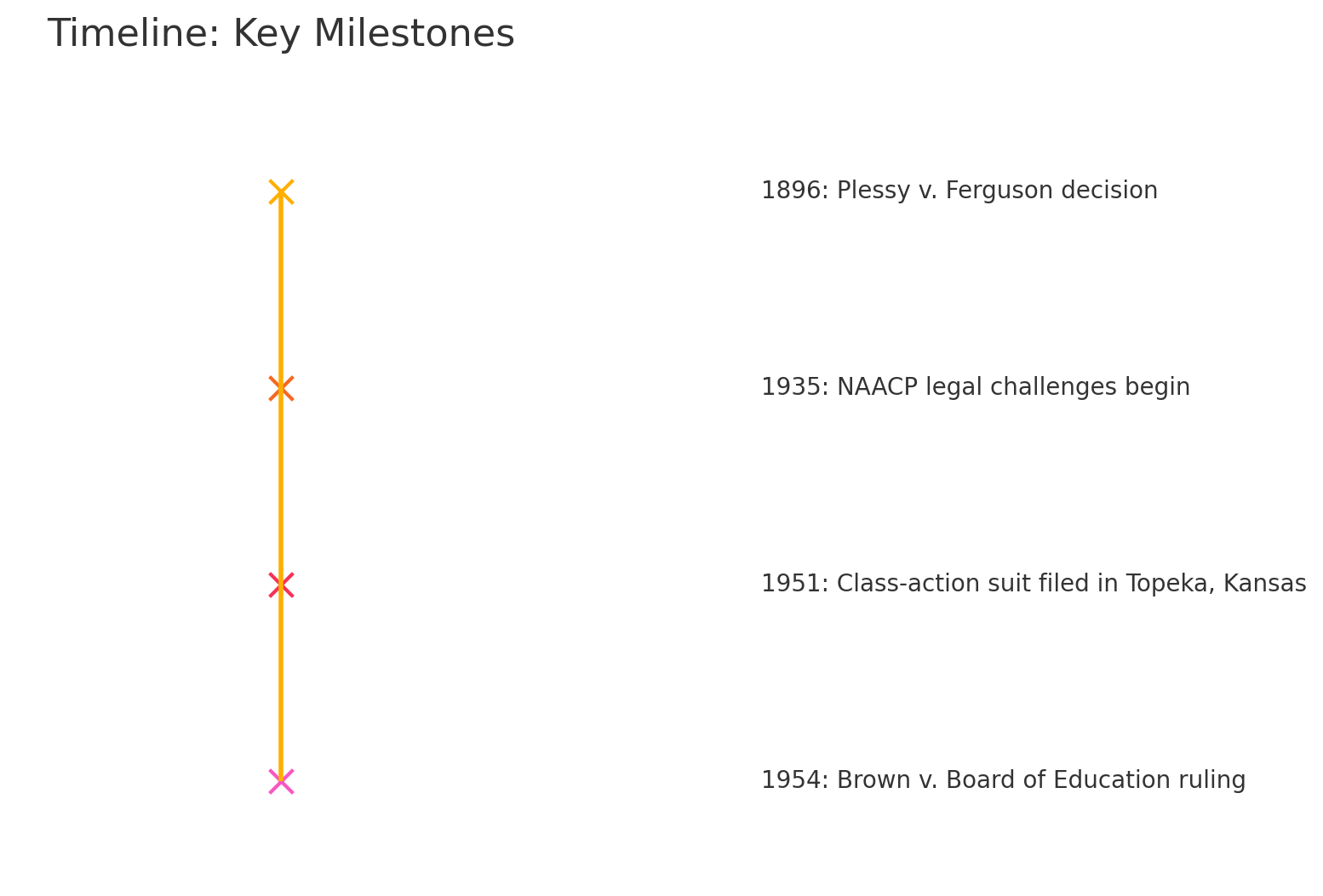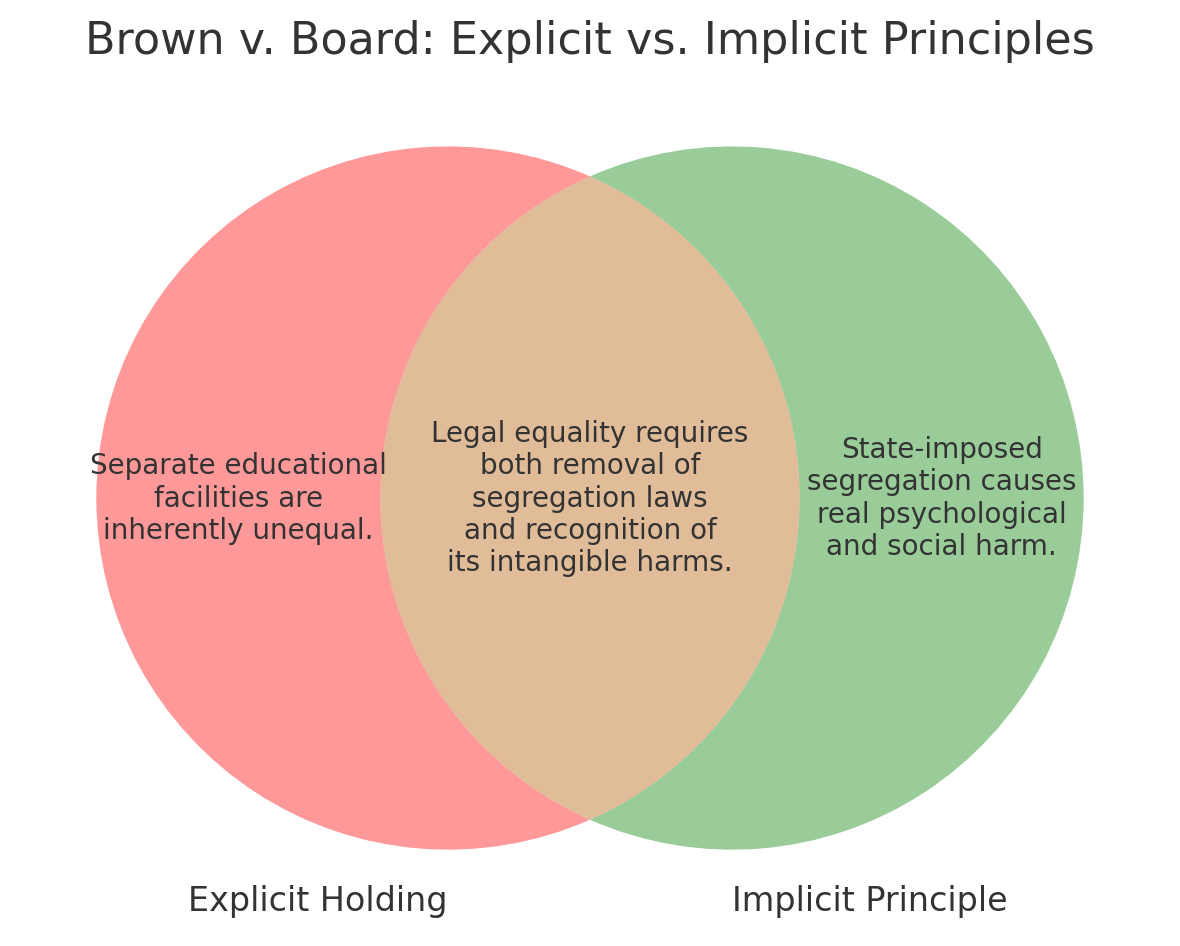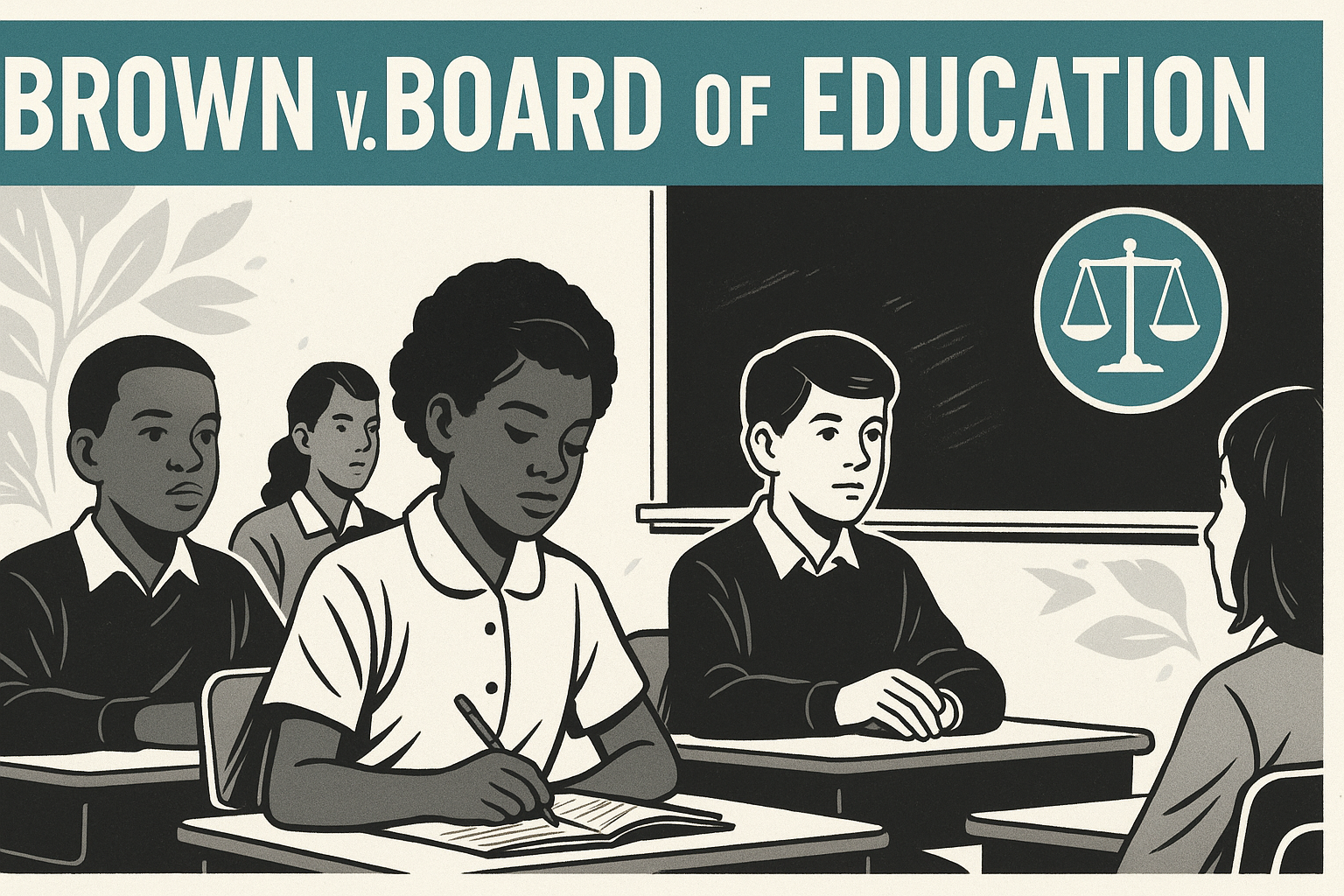Quick Answer: The Brown v. Board of Education decision implied that state-sanctioned segregation in public schools was inherently unequal and thus violated the Equal Protection Clause of the Fourteenth Amendment—effectively repudiating the “separate but equal” doctrine and laying the constitutional groundwork for broad desegregation. Beyond overturning Plessy v. Ferguson, the Court recognized that segregation inflicted psychological harm on minority children and undermined true equality under the law, signaling that legal equality must account for both tangible and intangible effects of separation.
Historical Context & Case Background
“What led to Brown v. Board of Education?”
Several forces converged to challenge the status quo of segregated schools:
- Plessy v. Ferguson precedent (1896): Established “separate but equal” under the Fourteenth Amendment, legitimizing Jim Crow laws nationwide. (Source)
- NAACP’s legal strategy: Beginning in 1935, Charles Hamilton Houston and Thurgood Marshall systematically targeted graduate and professional school segregation, building precedents that culminated in Brown. (Source)
- Topeka school conditions: In 1951, Oliver Brown and twelve other Black families sued after their children were forced to attend distant, underfunded segregated schools rather than the neighborhood white schools.
Visit:
How to Improve Concentration
How to Study Effectively
Proven Strategies to Increase your Focus

“Which best describes the Brown v. Board decision?”
Answer:
It declared that “separate educational facilities are inherently unequal,” overturning the “separate but equal” doctrine in public schools.
“In the field of public education…the doctrine of ‘separate but equal’ has no place.” — Chief Justice Earl Warren, Brown v. Board of Education
The Implied Principles Behind the Ruling
“Which of These Statements Was Implied by Brown v. Board?”
- Segregation violates the Equal Protection Clause of the Fourteenth Amendment
- Separate educational facilities are inherently unequal
- States must dismantle school segregation policies
- De jure segregation inflicts psychological harm on children
- “Separate but equal” cannot coexist with true equality

“What Was the Supreme Court Decision in Brown v. Board of Education Based On?”
The Court’s unanimous ruling rested on two pillars:
- Fourteenth Amendment’s Equal Protection Clause — the mandate that no state shall “deny to any person within its jurisdiction the equal protection of the laws.”
- Social Science Evidence — notably the Clarks’ doll studies demonstrating that enforced separation produced feelings of inferiority among Black children, undermining their educational development and self-esteem.
“Social science research influenced the Court’s understanding of psychological harm.”
“What Did the Supreme Court Ban in Brown v. Board of Education Decision in 1954?”
Answer:
It prohibited state-sanctioned racial segregation in public elementary and secondary schools, declaring such laws unconstitutional under the Fourteenth Amendment.
Tip Box:
“Remember: Brown targeted de jure segregation—legal mandates enforced by the state—not private or de facto segregation arising from housing patterns.”
Also, Visit:
What is Work Study?
Average Cost of College
How to Study for the LSAT?
Implementation & Aftermath
“What Was the Time Frame for Integration of Schools in the US?”
Short Timeline:
- 1954–1955: Following the Brown decision, districts begin planning desegregation.
- 1957: Little Rock Central High School crisis forces federal intervention.
- 1964: Civil Rights Act authorizes federal enforcement of school desegregation.
- 1970s: Court-ordered busing expands integration beyond initial districts.
Step-by-Step Illustration:
- May 1954: Supreme Court issues Brown v. Board of Education ruling.
- September 1957: Nine Black students (“Little Rock Nine”) escorted by federal troops into Central High.
- 1964: Title IV of the Civil Rights Act empowers the Justice Department to file desegregation lawsuits.
- 1971: Supreme Court’s Swann v. Charlotte-Mecklenburg decision upholds busing as a tool for integration.
“What Did the Supreme Court Rule in Brown v. Board of Education Quizlet?”
Quiz-Style Callout:
- Separate but equal is unconstitutional.
- Equal protection applies to public education.
- Schools must desegregate with “all deliberate speed.”
“Desegregation ‘with all deliberate speed’ became both clarion and criticism.”
Legacy & Modern Relevance
“How Brown Shaped Later Civil Rights Rulings”
Brown v. Board of Education set a powerful precedent for dismantling state-enforced discrimination far beyond public schools. In Loving v. Virginia (1967), the Court struck down bans on interracial marriage by invoking the Equal Protection principles first crystallized in Brown. Later, Swann v. Charlotte-Mecklenburg (1971) embraced judicial remedies—like busing—to achieve integration, directly building on Brown’s mandate to eliminate de jure segregation. (Source) (Source)
These decisions illustrate Brown’s ripple effect: it transformed the Fourteenth Amendment into a living promise of equality, empowering courts to confront discriminatory laws across housing, marriage, and employment.
“Why Brown Still Matters in 2025”
Despite six-plus decades of legal progress, Brown’s core message remains urgently relevant. A 2024 UCLA Civil Rights Project report finds that racial and economic segregation in U.S. public schools is on the rise, with many districts re-segregating due to residential patterns and charter-school expansion (Source). At the same time, cutting-edge tools—like AI-driven school-quality assessments—are spotlighting inequities by mapping resource gaps and performance disparities in real time.
Brown endures as both a legal touchstone and moral imperative: it reminds us that formal equality is insufficient without continuous vigilance against intangible harms and systemic barriers.
Fact Box:
Over 65 years later, public school segregation is resurging in many districts.
Frequently Asked Questions
Which best describes the Brown v. Board of Education decision?
It ruled that state-mandated segregation in public schools violates the Equal Protection Clause because “separate educational facilities are inherently unequal.”
What was the Supreme Court decision in Brown v. Board of Education based on?
The Fourteenth Amendment’s Equal Protection Clause, supported by social science evidence showing segregation’s psychological harm to Black children.
What did the Supreme Court ban in the Brown v. Board of Education decision in 1954?
State-sponsored racial segregation in public elementary and secondary schools.
What did the Supreme Court rule in Brown v. Board of Education (Quizlet)?
- Separate but equal is unconstitutional.
- Equal protection applies to education.
- Schools must desegregate with “all deliberate speed.”
What was the time frame for integration of schools in the US?
Key phases:
• 1954 – Brown ruling
• 1957 – Little Rock crisis
• 1964 – Civil Rights Act enforcement
• 1970s – Court-ordered busing
• Continuing desegregation efforts today

